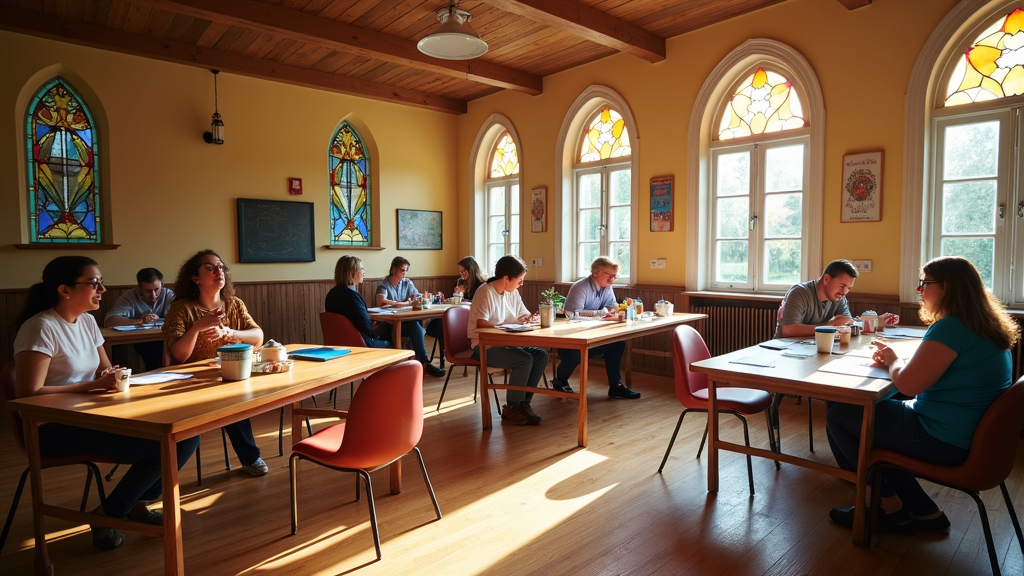Bringing together a strong volunteer team is such a smart move for any faithbased organization. Volunteers bring new energy, compassion, and skills into the community, making outreach and service possible. I’ve watched incredible things happen when people unite, inspired by shared faith and purpose. Jumping in without a plan, though, can lead to burnout or confusion. Here’s how I go about building teams that are both thriving and sustainable.

Start With Calling, Not Just a Task List
People don’t usually stick around just because there’s work to be done; they’re drawn in when they believe what they’re doing really matters. Instead of only posting a “needed volunteers!” sign on the bulletin board, I frame new opportunities as invitations to serve using personal gifts and passions. Help others see their involvement as meaningful, whether they’re welcoming newcomers, running tech, teaching kids, or blessing the congregation behind the scenes.
Scripture really backs this up: “Each of you should use whatever gift you have received to serve others…” (1 Peter 4:10). This gives everyone permission to figure out where they’re best called to serve, not just fill slots.
- Tip: I often share a simple gifts or strengths survey after services or during small groups. It’s eyeopening how often people volunteer when they feel seen and valued for who they are and not just what they bring. You can also make this process more fun by inviting volunteers to share their stories, which helps others recognize their own strengths.
RelationshipFirst Recruiting Beats Announcements
Most people I know want to feel welcomed and known. When I’m building teams, my first step is personal outreach, whether it’s casual chats after church, invitations to grab coffee, or sending a text to someone who’s shown interest. Warm invitations always work better than general appeals. People naturally feel more invested when someone reaches out personally and shows genuine care for their interests.
- Host a “Team Night.” Gather people for food, fellowship, and a behindthescenes look at roles. Give everyone a “test drive” opportunity so they can see if a volunteer spot feels like a good fit. Sometimes, rotating these team nights with new themes increases participation and lets more people sample what volunteering involves.
- Make specific asks. I find people are much more likely to say yes to, “Could you help at the welcome desk for two Sundays next month?” rather than the general, “Do you want to help out?” Being specific helps remove uncertainty and gives volunteers manageable entry points.
- Share stories and impact. Talk often about the difference volunteers have made. Sharing quick wins and changed lives keeps everyone’s eyes on the mission rather than just the chores. Consider making space during services to share these stories publicly; it can really give a boost to the team’s morale.
Role Clarity and Flexible Commitment
Nobody likes to say yes to something and then realize later they have no idea what’s expected of them. I’m a huge fan of making volunteer roles super clear from the start. Even a onepage description helps potential team members understand what’s needed, how long it’ll take, and who they’ll work with. Transparency around expectations sets up both volunteers and leaders for success.
- Seasonal and shortterm options. Not everyone can commit every week. I like offering flexible spots, such as covering a Christmas event, joining an Easter outreach, or filling in twice a season on the AV team. Flexible commitment often opens doors for new volunteers and reduces hesitancy among those with busy lives. If you allow people to step back and return anytime, it steers clear of overwhelming any single person.
- Written descriptions. Titles, estimated hours, training info, and what success looks like are all details worth providing. Sharing this in advance shows respect for a volunteer’s time and helps ensure they start with confidence.
Easy Onboarding and Supportive Training
Jumping into a new volunteer role is exciting but can be intimidating. I break onboarding into a few simple steps so nobody feels overwhelmed. The first experience sets the tone, so it’s important to keep things welcoming and easy to understand.
- Pairing up. New people get paired with experienced volunteers for their first few times. This encourages friendships, builds trust, and answers questions on the spot. It also gives veterans a chance to nurture community as they help new faces find their groove.
- Preservice huddles. 10 or 15 minute meetups right before services or events help everyone sync up and feel ready to go. These gatherings are also perfect for sharing encouragement, instructions, and even lastminute changes, so nobody feels left out.
- Quarterly “Equipping Nights.” Some skills or roles need deeper dives. I set aside time for training, sharing updates, and growing together, often with some good food in the mix. Even short video walkthroughs for things like AV tech or Sunday school lessons can help people feel comfortable in their roles. An online library of training materials can also be useful—this way, volunteers can revisit details whenever they need a refresher.
Creating a Welcoming Volunteer Culture
People stick around when they feel noticed, appreciated, and part of a team. Building a culture that values and encourages volunteers is basically more important than any signup sheet or program I could create. It’s not just what people do, but how they feel while doing it.
- Personal appreciation matters. I never underestimate the power of a handwritten thankyou note or a simple checkin text. Occasional “Volunteer Recognition Sundays,” team shoutouts, or small appreciation gifts go a long way. These acts create a positive feedback loop that helps volunteers feel respected and loved for their efforts.
- Build connection outside of tasks. A group chat or a private social media group can help keep everyone connected. Annual gettogethers—picnics, retreats, or game nights—make everyone feel like they belong and aren’t just another pair of hands. Friendship and camaraderie hold teams together even when tasks change.
- Feed souls, not just schedules. A fiveminute devotional or prayer before each gathering reminds everyone that what they’re doing connects to something bigger. These spiritual touchpoints can anchor people in their faith and motivate deeper commitment to serving together.
Spotting and Addressing Volunteer Burnout
Even the most enthusiastic volunteers can get tired or stretched thin. Burnout can show up as dropping commitments, disengagement, or even frustration. I pay attention to warning signs and respond with care. Staying sharp and nurturing rest is vital for longterm ministry.
- If someone starts missing shifts regularly or seems less upbeat, I gently check in: “How are you doing? Is your schedule still working for you?” Just letting people know you notice can be powerful. Sometimes a quick chat or coffee break lifts their spirits.
- Offer time off or different role options, especially if their life circumstances have changed. Sometimes, someone just needs a break or wants to try a new area of service. Don’t be afraid to suggest a pause—they’ll likely return later refreshed.
- Always pray with and for volunteers. Even a short prayer can help people feel seen and remind them they’re valued far beyond what they do. This spiritual care can sustain your team through busy seasons and tough challenges.
It’s really important to remember Jesus’ words: “Come to me, all you who are weary and burdened, and I will give you rest.” (Matthew 11:28). Encouraging healthy rhythms, making space for breaks, and sharing scripture help teams stay healthy over the long run.
Practical Barriers and Creative Solutions
Even with a great process in place, faith communities run into a few common hiccups. Here’s how I like to handle them:
- People aren’t sure what their gifts are? Offer fun discovery workshops, or bring in leaders to share what different teams do. Sometimes, hands-on experience is the easiest way to figure out where someone best fits.
- Limited time? Many folks can only offer a couple hours per month, so mix in onetime events, make schedules visible online, and let people sign up for what works for them. Understanding people’s schedules and offering flexibility ensures you don’t miss out on awesome volunteers.
- Communication issues? I keep everyone posted with a simple monthly volunteer newsletter highlighting open spots, upcoming events, and favorite stories. Including photos and shoutouts in these updates keeps everyone engaged and in the loop.
Advanced Tips for Growing Volunteer Teams
Once a volunteer culture is in place, I like to help team leaders take things up a notch with these ideas:
- Develop future leaders. Notice who’s thriving on the team, and ask if they want to help coordinate others, mentor new folks, or brainstorm creative project ideas. Leadership rotation helps prevent burnout and surfaces new strengths from within your community.
- Celebrate wins, big and small. Share stories of impact during worship services or put a highlight in the weekly bulletin. Spotlights make everyone feel proud to contribute and help new volunteers see what’s possible.
- Ask for feedback. Annually, I send out a quick survey: How’s your experience? Any ideas for improvement? Keeping the process open means volunteers know their opinions matter. Acting on feedback shows respect and builds trust between leaders and teams.
Common Questions About Volunteer Ministry
Here are a few questions (and honest answers) I get most often about building volunteer teams in faith settings:
Q: How do I know where to serve?
A: Start with what gets you excited or where you see a need. Trying out different teams for one or two events is the easiest way to find your spot. You’ll get a sense of fit by connecting with leaders and shadowing different roles.
Q: What if I only have a little bit of time?
A: Many teams have monthly or seasonal spots. It’s totally okay to help occasionally; every bit counts, and mixing up schedules lets more folks take part. Don’t worry about saying no if your plate is full—there’s usually a spot for every schedule.
Q: How do I keep volunteers committed longterm?
A: Stay connected, celebrate contributions, and make room for growth. Encouragement and purpose tend to keep people involved way longer than duty or guilt trips. Listening and adjusting to feedback also goes a long way.
If you’re searching for practical resources, toolkits for team building, or ideas for training, there are plenty of free templates and guides from organizations like VolunteerMatch and the Evangelical Council for Financial Accountability (ECFA). Try searching “ministry volunteer resources” for even more options, including customizable documents and video tutorials.
Got tips or favorite teambuilding practices that have worked for your ministry? Drop your thoughts below—I love learning new ideas from others who are in the field! Together, we can help volunteer teams grow stronger and make real impact for our faith communities. Keep building, sharing, and serving.
SEO Keywords: “church volunteer ideas”, “building church volunteer teams”, “volunteer retention strategies”, “Christian service opportunities”
